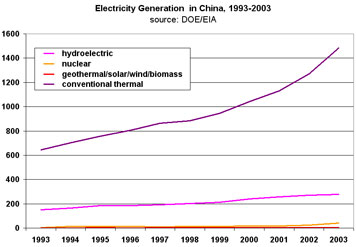Wind turbines could power China says expert
Rhett Butler, mongabay.com
March 9, 2006
Wind could become China’s second-largest source of electricity according to a Chinese energy expert.
Wang Weicheng, an energy professor at Tsinghua University in Beijing, told reporters that China has the potential to install up to 100 gigawatts of wind power.
“By 2020, wind power capacity is predicted to reach 30 gigawatts,” said Wang in a meeting at China’s annual parliament. “Around the mid-21st century, wind power is very likely to take the place of hydropower as the second-largest source of electric power generation after coal.”
He added that wind power could surpass nuclear stations as a source of energy within 20 to 30 years.
Wang’s comments come as China has been aggressively expanding its interests in renewable energy sources including wind, solar, biofuels, tidal, and small hydroelectric dams.
In February 2005, the government passed a renewable energy law that both requires power operators to buy electricity from alternative energy providers and provides economic incentives to such producers. China is striving to reduce its dependence on traditional coal, which supplies 65-70% of the country’s energy needs but is responsible for a number of its energy-related environmental problems. According to a recent report by the World Health Organization (WHO), seven of the world’s ten most polluted cities are in China and almost two thirds of the country’s largest cities fail to meet the organization’s air quality standards. With its use of unwashed coal, China is the planet’s largest emitter of sulfur dioxide and acid rain plagues about a quarter of the countryside. The World Bank estimates that pollution is costing the country 8-12% of its $1.4 trillion GDP in direct losses.
China has expressed a strong interest in cleaner coal-based technologies like coal liquefaction and gasification, but the government appears to put official hope in renewable energy, setting a target of 12% of its power generation capacity, or 20 gigawatts, coming from renewables by 2020—up from a mere 3% in 2003. The government’s interest in reducing China’s use of coal and petroleum products extends beyond environmental and health concerns; it sees both the strategic value of mitigating its reliance on foreign oil and the economic advantages of being on the technological leading edge of energy production.

WORLD WIND POWER RELATED ARTICLES |
The passage of the Renewable Energy Promotion Law appears to be the first step in making this goal a reality. The legislation, which took effect earlier this year, gives funding and tax incentives to renewable energy projects. Environmentalists hope the sheer size of the Chinese market will spur further interest in the economic prospects of renewable energy well beyond the borders of China.
“China’s anticipated entry into the global renewable energy market is expected to have a profound impact on the global industry,” said Li Junfeng, Secretary General of the Chinese Renewable Energy Industry Association, in a release from environmental group, Greenpeace. ‘We have spent a lot of time and energy learning from the successes and failures of our partners in Europe and around the world. We believe that this law can start a renewable energy revolution in China.”
China is off to a quick start in its renewable energy push. The market for wind energy in China grew by 35% in 2004 and in 2005, the country added 500 megawatts of new wind power capacity. This year the country plans to start construction of an offshore wind power complex designed to have a generating capacity of 1 gigawatts when completed in 2020. The government is reportedly even more optimistic than Wang, stating that wind power potentially could generate 253 gigawatts in the future.
Beyond wind power, the Chinese government has sponsored research into the development of fuel cells, tidal power station technologies, and biofuels. The country, which already has the world’s largest biofuels plant, is working with European agencies to see how plant matter and animal waste-based fuels might serve as alternatives to fossil fuels.
This article used information from previous mongabay.com articles, Reuters, The Economist, DOE/EIA, Windpower.org, Greenpeace, the Australian Wind Energy Association, Oxford University, and a presentation by Dr. Gerritsen of Stanford University.
